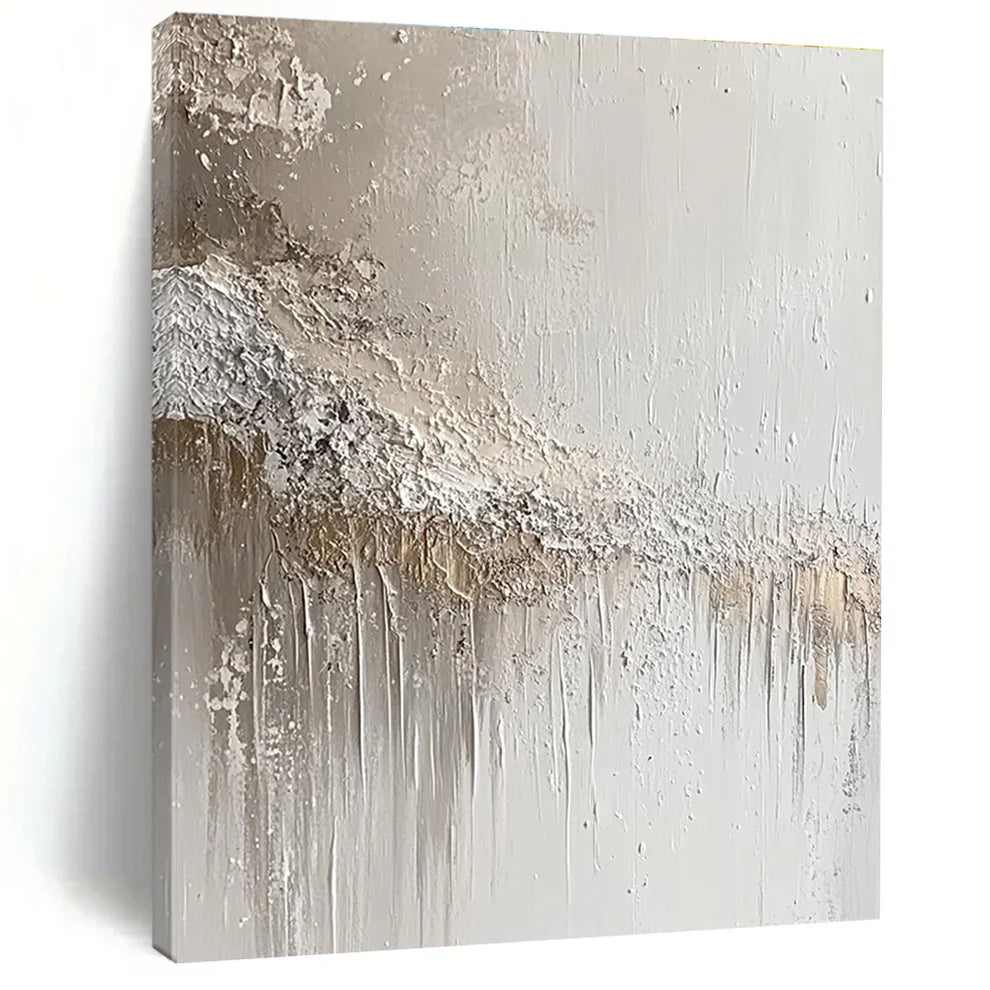
A Study in Texture and Tone - Deconstructing a Minimalist White and Beige Abstract
Share
Some abstract paintings find their power not in a riot of color, but in the subtle interplay of texture, tone, and form. This striking piece, the Textured White and Beige Abstract for Minimalist Home & Spa Retreat STSC843, is a perfect example. It's a work that feels less like a static image and more like a captured moment of geological formation or a quiet, weathered wall. As a key piece within the collection of Hallway Wall Art, this canvas stands out for its calming palette, its minimalist approach, and its sophisticated, textural depth.
The painting’s content is a masterful study in visual simplicity and a deliberate focus on tactile quality. The canvas is a monochromatic field of white and beige, with a striking, diagonal band of texture running across its middle. The paint is applied with thick, heavy strokes, creating a powerful sense of sculptural relief. This central band, with its varied tones of beige, white, and hints of gold and gray, feels like a rugged mountain ridge, a cracked and weathered wall, or a vein of precious metal running through rock. This emphasis on creating a tactile surface is a testament to the artist's use of impasto, a technique where paint is applied so thickly that it stands out from the surface. The technique itself becomes a form of expression, as the viewer is invited to appreciate the physical quality of the paint. The Tate Modern has excellent resources on the history and application of this technique.
The power of this painting lies in its ability to evoke a specific emotional response through its minimalist composition and subtle palette. The colors themselves, while few, hold symbolic weight. White and beige are often associated with purity, simplicity, and tranquility, while the gold and gray tones hint at age, value, and stability. By forgoing bright colors, the artist invites the viewer to be immersed in the art itself, to focus on the interplay of light and shadow on the textured surface. The work is meant to be experienced, not just seen, and its subtle sophistication makes it a perfect fit for a space meant for quiet reflection. The final effect is a painting that feels both contemporary and deeply personal, a testament to the idea that a painting can express profound emotions without relying on representational imagery. For a broader understanding of how artists use texture to convey meaning, the Museum of Modern Art (MoMA) offers a wealth of information.

The Artist's Vision and Journey
The artist’s creative philosophy is deeply rooted in a fascination with the textures and forms of the natural world. Their work is a deliberate exploration of how a painting can capture the feeling of a landscape without a literal depiction. The artist’s journey began with a love for geology and the quiet, monumental beauty of rock formations and weathered surfaces. They found that the most profound beauty was often in the subtle shifts of light and shadow on a rough surface, and sought to translate that feeling onto canvas.
The creative process for this painting is a meditative and deliberate one. The artist starts by building the composition with broad, structural strokes, establishing the central, diagonal form. The paint is then applied with a focus on creating a rich, textured surface, using tools like a palette knife to build up the layers of impasto. The artist sees the work as a form of visual poetry, where each texture and tone contributes to a larger feeling of tranquility. Their goal is not to create a detailed image, but to capture a memory or an emotion and allow the viewer to connect with it on a personal, intuitive level.

Customer Reviews
"This painting is absolutely incredible. The texture is amazing and it adds so much depth to my living room. It’s calming and sophisticated, and I get compliments all the time." - Jessica L.
"I was looking for a subtle piece of art that wasn't too loud, and this one is perfect. The minimalist style is so elegant and the texture is beautiful. It feels very high-end and unique." - Ryan P.
"The quality is fantastic and it has completely transformed my living room. It's a very calming piece of art that I never get tired of looking at." - David S.
Frequently Asked Questions (FAQ)
Q: Is this an original painting or a canvas print? A: This artwork is a high-quality reproduction of an original painting. The unique textures and subtle color fields are meticulously recreated to provide a finished product that is visually and tactilely rich.
Q: How do I clean and care for this textured canvas? A: We recommend cleaning this painting by gently dusting it with a soft, dry cloth or a feather duster. Please do not use water, chemical cleaners, or abrasive materials, as they could damage the surface.
Q: Does the painting come with hanging hardware? A: Yes, all our canvases come with the necessary hardware pre-installed on the back, so it is ready to hang as soon as it arrives.
Q: Can this piece be hung in a room with a lot of natural light? A: The canvas and inks are made with high-quality, fade-resistant materials. However, to ensure the longevity of the colors, we recommend hanging the artwork in a location that avoids constant, direct sunlight.
Q: What is the best way to light this painting to show off the texture? A: A single-source light, such as a spotlight or a track light, positioned to hit the canvas at an angle, will beautifully highlight the textured brushstrokes, giving the painting a dynamic, three-dimensional quality.
